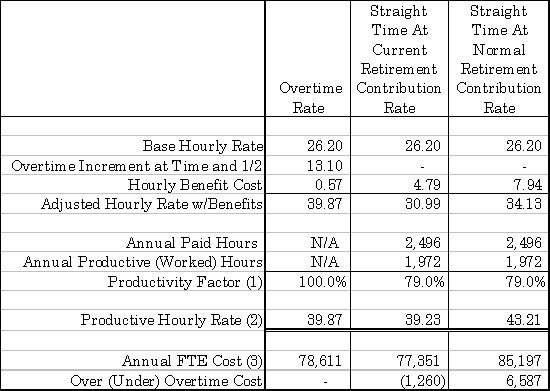1.7 Disability and Workers Compensation
|
This section of the report addresses cost and control issues related to industrial injuries and disability, including the direct cost of paying these benefits as well as the indirect cost of replacing absent workers with relief and overtime employees. Further, as costs increase from employee absences and the corresponding requirement to use relief and overtime staff, there is the eventual potential for deterioration in service quality.
Included among the categories of employee leave examined in this section are workers compensation, sick and disability leave. Although not a leave category, temporary modified duty (also referred to as limited duty) is also discussed because of its impact on relief staffing and overtime.1
Absences in these categories represent a substantial portion of the total amount of leave taken in the Department. Sick leave accounts for nearly 30 percent, and disability pay accounts for nearly 25 percent of the total. Limited duty represents another 10 percent, which brings the subtotal for these three categories to almost 65 percent of all regular duty absences for fire suppression duty, based on FY 2000-01 expenditures. In addition to the substantial cost impacts, these specific areas were selected for review because of the potential for management to intervene and attempt to reduce costs.2
The Budget Analyst"s approach to the analysis of these costs focuses on the Department"s high rate of overtime expenditure. As noted above, the four specific drivers of relief staffing and overtime (workers compensation, disability, sick and limited duty) have direct costs that are substantial. In fact, the cost of overtime, workers compensation and disability pay alone exceeded $24 million in Fiscal Year 2000-01, which was more than 11 percent of the Department"s current year operating budget. When adding the cost of regular sick leave, the million-dollar cost of the Wellness Program and the difficult-to-quantify cost of temporary modified duty, these significant costs are even greater.
As a guide for this section of the report, the connecting thread is that it discusses the above items individually, yet each one must be viewed in terms of its singular and direct impact on the Department"s overall expenditures, as well as its indirect impact on relief staffing and overtime usage.
Overtime
The Fire Department"s annual overtime expenditures have risen from $3.4 million in FY 1993-94 to $10.9 million in FY 2000-01, an increase of $7.5 million or 222 percent over eight years. In all but three of these years, the Department has overspent the annual budget amount for overtime, as demonstrated in Table 1.7.1, below.
Table 1.7.1
Comparison of Budgeted to Actual Overtime
San Francisco Fire Department 1994 through 2001
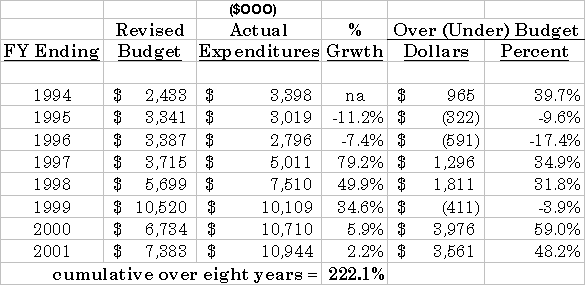
A critical measure and principal driver of overtime in the Fire Department is the level of relief staffing required to meet the minimum daily staffing requirement defined by management and included in the Memorandum of Understanding with the firefighters, (i.e., hiring additional personnel, or assigning employees to work overtime when they are otherwise scheduled to be off from work, known as working on a day off, or WDO)3. Thus, for measurement and analytical purposes, WDO serves not only as a driver but also as a surrogate for overtime. In this context, it is clear that overtime has cost impacts that are often understated.
For example, annual vacations are bid annually and awarded on the basis of rank and seniority, and some long term absences are anticipated. This always allows for advance scheduling of replacement employees who provide-and are referred to as relief. In this circumstance, the Department pays twice for the position: (1) the vacationing or long-term sick employee, and (2) the replacement employee, who are both paid at straight time. However, for employees on unscheduled sick leave, disability leave or assigned to limited duty, a portion of the relief is accomplished with WDO hires (some limited scheduling against this leave is possible). In these circumstances, the common perception is that the Department pays two and one-half times for the position: (1) the employee on leave at straight time and (2) the WDO relief employee at time and one-half.4 While most short-term leave usage is legitimate, sick leave and disability leave are two of the short-term types that provide ample opportunity for abuse and, therefore, deserve closer scrutiny by management through the use of improved automated reporting. The SFFD Human Resources Division and Assignments Office staff are in the best positions to design and develop reports that fill this need, and should work with the Human Resources Department"s Workers Compensation Division to coordinate the interface between internal and external management information systems.
Employee Supply and Demand
In general, high rates of overtime use result from various combinations of factors, including a limited supply of available employees and varying levels of demand for workers. The supply (a certified pool of qualified employees in different classifications), is affected to some degree by separations (retirement, discipline, resignation, and death), examinations, promotions, eligibility lists and approved requisitions. Demand is driven by absences that are both scheduled and unscheduled. Underlying both the supply and demand sides of this equation is the minimum daily staffing requirement for fire suppression coverage, embodied in the firefighters MOU.
There are indications that this pool of employees may be shrinking as the workforce ages and retirements increase. Table 1.7.2, below, shows a projection of suppression personnel eligible for retirement over the next seven years.5 While all eligible employees may not necessarily retire as soon as they are eligible, it is important that management be aware of the order of magnitude of this potential phenomenon. Further, as will be discussed later in this section, there is a greater probability that firefighters will file disability claims as they approach retirement age. Therefore, it is important that management vigorously scrutinize all new claims by active uniformed personnel. This represents another reason why the Department should work with the Department of Human Resources Workers Compensation Division to enhance the Fire Department"s information system and improve its ability to track claims information internally, as well as interface with the DHR/WCD system.
Table 1.7.2
Projection of Retirement Eligibility for
Current Suppression Workforce, 2001 - 2007
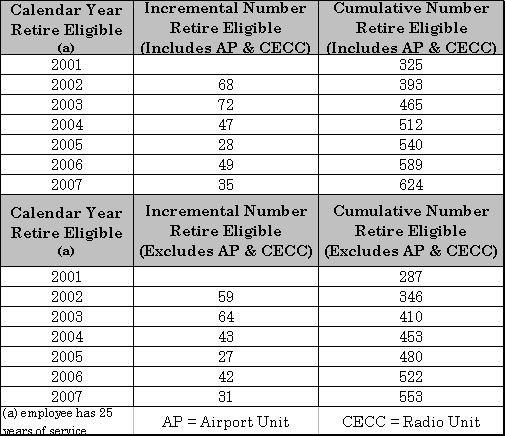
During our review, it initially appeared that the larger the pool of employees scheduled for duty, the fewer the number of WDOs needed to meet the minimum staffing requirements for the Department. This was especially apparent during part of last fiscal year. For example, a daily average of 45 WDOs represented 11 percent of the average 406 employees scheduled for duty in July 2000, and an average of two WDOs represented only one-half of one percent of the average 428 employees scheduled in February 2001. High WDO proportions characterized the first half of that year and very low proportions marked the second half, bringing the annual average to 21 WDOs, or five percent of the 421 employees scheduled for duty.
However, we expanded this analysis for a seven-year period and found that during the first three years, the Department averaged 13 WDOs per 388 scheduled employees (or 3.4 percent of scheduled employees). During the most recent four year period, the average increased to 19 WDOs per 405 scheduled employees (or 4.7 percent of scheduled employees). Therefore, the trend noted during the second half of Fiscal Year 2000-01 suggests that low WDO proportions are uncharacteristic, and that typically the Department requirement for WDOs increases with the total number of scheduled personnel. In fact, during the last four years, the WDO requirement seems to have increased at a greater percentage rate than the growth in the number of scheduled staff.
This is a further illustration of the importance of an accurate and strong database covering all aspects of leave usage, especially the ability to perform longitudinal analyses to develop realistic projection factors.
Overtime Costs
Various factors, such as the number of paid hours that employees work and the cost of benefits, determine whether it is most economical to backfill vacancies on "straight time" (e.g., full time employees) or with overtime. In the Fire Department, current experience suggests that overtime is more costly than straight time. However, savings would occur and be substantial if the City were required to fund the full amount of the employees retirement contribution on a current basis.6 In the long term, overtime is less costly than straight time since the current cost of retirement is possible merely because of significant earnings on savings the City has set aside in previous years, and the accumulation of surplus funds in the City"s retirement accounts.
The following table demonstrates the differences in straight time and overtime cost.
Table 1.7.3
Comparison of SF Firefighter Compensation Rates
Straight Time versus Overtime
(1) Full-time employees are paid for 2,496 hours, but work an average of only 1,972 hours per year. The balance of 524 hours are paid to employees while they are off for vacation, sick, workers compensation, disability and other forms of leave. By dividing the average hours worked by the total hours paid, a productivity factor can be computed (the proportion of hours when employees are productivity engaged in their job duties). Since employees are only paid for actual hours worked, the productivity factor for overtime is 100%.
(2) The Adjusted Hourly Rate with Benefits, adjusted by the average Productivity Factor, to arrive at a rate of pay that the City effectively pays to employees for every hour that they actually work.
(3) The annual FTE cost is computed by multiplying the Productive Hourly Rate by the average number of Annual Worked Hours (averaging 1,972 for a full-time employee).
As shown in the table, it costs the City approximately $1,260 per year for each FTE that is backfilled by overtime instead of by a full-time employee. In total, this incremental difference costs the City approximately $119,680 per year, based on the average number of WDOs required to operate the Department each day, the average productivity of the Department employees during the past four years, and current salary and benefit costs. However, if the City were paying the normal retirement contribution rate, the use of overtime instead of straight time would produce annual savings of approximately $625,665 per year.
It is important to note that the cost differential between overtime and straight time can be significantly impacted by changes in average employee productivity. If the average number of hours worked by Fire Suppression staff increased by a mere one-half of one percent, the current incremental cost of paying overtime instead of straight time to backfill for vacancies would completely dissipate. To the extent that the average number of worked hours increased above these levels, the City could save substantial amounts in personnel costs. The following example demonstrates the significance of productivity on Department costs.
· In FY 2000-01, the Department scheduled an average of 420 employees each day to provide fire suppression services, yet an average of only 330 of these employees actually worked. If an average of only one additional employee out of these scheduled staff reported to work each day, the Department could have saved over $340,000 in overtime and relief staffing costs in that year. If the Department were able to reduce absences from scheduled duty by only five percent (averaging less than five employees per day) the City could save over $1.6 million per year in relief staffing costs.
As illustrated by this example, even small improvements in employee productivity would eliminate the cost currently experienced by using relief instead of scheduled employees, and quickly produce additional savings for the City. For these reasons, it is important that the Department implement procedures and practices which help to control sick, disability and other leave, and reduce the number of worker injuries which result in limited duty assignment.
Overall, this is a complex area with intricately interrelated components that can best be dealt with in a comprehensive and coordinated manner. Currently, the Department lacks such a program.
Sick Leave
Backfilling for employees on sick leave is a significant reason for relief staffing costs in the Fire Department. The City has attempted to reduce sick leave usage rates, beginning two years ago, through the Wellness Program. This program was intended to eliminate the abuse of sick leave, and the reduced use of sick leave was expected to be a measure of program effectiveness. Additionally, the Program was seen as another tool for reducing the Department overtime requirements. The Wellness Program was summarized as follows for the Board of Supervisors Finance and Labor Committee (7/21/99):
"once a core account of 360 hours of sick leave has been accrued for each employee, suppression employees can cash out 60 hours and non-suppression employees can cash out 50 hours of sick leave hours. Previously, there was no provision for cashing out sick leave hours and employees can accumulate up to 1,272 hours of sick leave. The Department of Human Resources notes that this provision should result in a significant reduction in overtime expenditures since overtime is required to backfill positions to cover for Firefighters who are out sick. However, the Department of Human Resources advises that there are no assurances that such reductions in overtime will actually be achieved."
In FY 1996-97, sick leave absences for Fire Suppression staff averaged 15.24 FTEs per day, increasing to 24.56 FTEs by FY 2000-01. This growth rate, in excess of 61%, is even more significant when considering that the growth in the number of employees scheduled for duty was about 17% during the same period. By comparing these two growth numbers, it is clear that sick leave has grown disproportionately with staffing. In fact, sick leave represented about 4% of scheduled employees in FY 1996-97, yet grew to nearly 6% by FY 2000-01. This is illustrated in Table 1.7.4, below.
Table 1.7.4
San Francisco Fire Department Employees
Scheduled for Duty and Off on Sick Leave
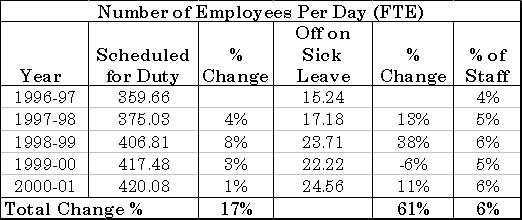
Provided below is a table of the Wellness Program payouts for Fiscal Year 1999-2000 by position classification, dollar amounts, and the number of employees in each class who were paid.
Table 1.7.5
SFFD Wellness Program Payouts
FY 1999-00 By Classification and Amount
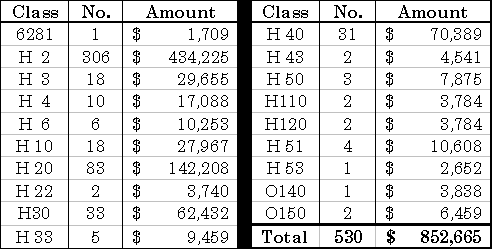
This expenditure of approximately $850,000 for 530 uniformed employees, covering the first year of the two-year agreement did not produce the desired results in terms of reduced use of sick leave or spending for overtime in the Fire Department.
In an attempt to remedy this situation, and continue the City"s planned reduction in the use of sick leave, the Department of Human Resources introduced a Pilot Wellness Incentive Program during recent bargaining agreement negotiations. The Department was able to obtain agreement to implement this program with 20 different bargaining units, including those representing firefighter employees.
Under the program, employees will be able to receive cash payment upon retirement for unused sick leave, based upon the employees" salary rate and years of service. The program enables covered employees to receive 2.5% of accrued sick leave credits, times the number of whole years of continuous service, times the employee"s salary rate upon retirement. This program, and currently proposed language to exclude sick leave from determining eligibility for overtime, are part of the City"s effort to decrease the use of unscheduled sick leave and to provide incentives to reduce the amount of sick leave use.
However, the Budget Analyst notes that in November 1978, the voters of San Francisco approved a Charter Amendment, which became Charter Section 8.363, stating that after 1978, employees hired by the City would not be entitled to receive cash payments or compensation of any type for accumulated unused sick leave. The current Charter, approved by the voters of San Francisco on November 7, 1995, does not contain the earlier voter-approved Charter Amendment prohibiting any compensation for unused sick leave. The Voter Information Pamphlet from that election is also silent on the issue, but under the section on Employee Retirement and Health Service System, states that the "proposed revision would make no significant changes in these areas."
Despite possible inconsistencies between the 1978 Charter and the provisions of the Wellness Incentive Program, the City Attorney"s Office advises that the current Charter places sick leave policy responsibility with the Civil Service Commission. CSC Rule 120 provides that no reimbursement for any unused sick leave after 1978 is permitted, "except as determined through collective bargaining." Such provisions were included in the Police and Fire collective bargaining agreements in 1999.
We generally support the efforts of the City to provide incentives to employees for reductions in the use of sick leave. However, the Fire Department, with the Department of Human Resources, should establish internal procedures to monitor sick leave use against the incentive program to validate its effectiveness, and the City Attorney should be asked to reexamine the legality of sick leave incentive payments that have been incorporated into the plan.
Disability
Disability pay, an adjunct of workers compensation, is provided to public safety employees in lieu of statutory indemnity payments for up to one year for each industrial injury.7 Disability pay for uniformed Fire Department employees, authorized by the Charter and addressed in the MOU, exceeded the total expenditure for workers compensation in three of the last seven years. In the six years following Fiscal Year 1994-95, the amount expended for disability pay more than doubled, increasing by 110 percent, while the amount spent for retiree costs increased by less than one-third. Based on an average of $85,000 annually for salary and mandatory fringe benefits, the $7.1 million in disability pay for Fiscal Year 2000-01 was equivalent to 84 firefighters.
Table 1.7.6
Analysis of Fire Department Workers Compensation
Costs,Including Costs for Retirees and Disability Pay
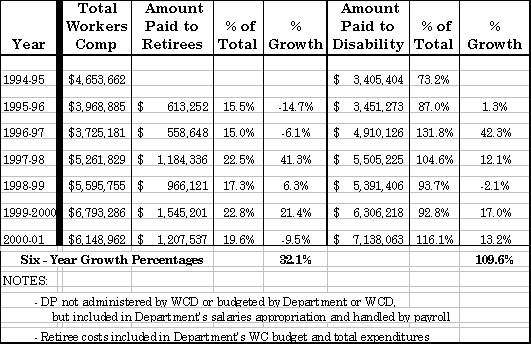
The level of disability claim activity in recent years has had a major impact on overtime and relief costs, averaging approximately 20 employees per day in Fiscal Year 2000-01. While the seven-year average was only 13 employees daily, during the most recent four-year period, absences due to disability was almost 19 employees per day.
One interesting aspect of the Department"s disability pay experience is presented in Table 1.7.7, below. This table shows that a seemingly high proportion of employees become disability pay claimants within one year of retirement eligibility. This data is consistent with a general perception within public sector management, that retiring public safety personnel have a high rate of disability claims.
We are not suggesting that these data provide evidence of any abuse by this group, although there were comments made during interviews conducted for this study that such abuse occurs. Nonetheless, given the significant number of Fire Department employees who will become eligible for retirement in the next several years (see Table 1.7.2), this is clearly a matter that bears closer scrutiny by management for its potential future cost impact. More specifically, all new industrial injury claims by active uniformed personnel should undergo vigorous scrutiny by the appropriate staff.8 Ultimately, the Department should consider converting uniform positions to civilian positions where appropriate to reduce disability pay exposure.9
Table 1.7.7
Summary of Fire Department Disability Claim Activity
Within One Year of Retirement Eligibility
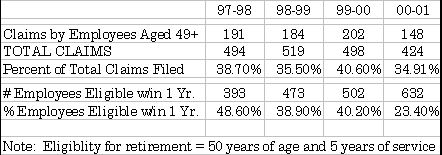
Source: CCSF/DHR/WCD
Workers Compensation
The Fire Department"s workers compensation expenditures in FY 2000-01 were within the budgeted amount, which was attributed to Return-to-Work efforts by the Department"s Physician and Medical Leave Supervisor.
In light of the disability pay provision for public safety personnel, workers compensation costs for the Fire Department are revealing in several ways. First, the proportion of indemnity costs to all other typical costs resulting from industrial injury are lower. Second, and further complicating the financial impact from this component, is the role of retirees. For a period of five years following separation from active employment, retired public safety employees are eligible for full coverage of costs associated with certain illnesses presumed to have resulted from their work. Retiree costs have averaged about 19 percent of the Department"s total for workers compensation over the past six years (please refer again to Table 1.7.6). Apart from the disability pay and presumptions regarding cause of illness, workers compensation provides 100 percent coverage for medical and other necessary treatment in contrast to the required deductibles of other insurance benefit programs for retired employees. This is an important incentive that should not be overlooked by the Department in the claims examination process.
The effect of retirees on the Department"s workers compensation expenditures is substantial and can be seen in the details of Exhibit 1.7.1. It shows an increased ratio of medical costs to temporary disability payments, ostensibly because:
· Public safety departments generally tend to use very little temporary disability:
¬ Public safety employees are eligible for disability pay, whereas other employees are not;
¬ There are presumptions in the statutes with benefits that accrue only to public safety employees; and,
¬ Retirees cannot use temporary disability but they make full use of the 100 percent medical cost coverage .
In the City and County of San Francisco, one-half of the total medical costs in workers compensation is incurred by the Police and Fire departments.
The significance of the workers compensation component of overtime usage is that it represents a cost driver fueled in part by retired as well as active employees. Additionally, it is understated by the amount of disability pay, an unbudgeted item paid directly from salaries. Finally, as shown in the projection of retiring employees, Table 1.7.2, future costs for this group are certain to rise in direct proportion to its increasing numbers. Management should be kept abreast of the relationship between the retiree population and workers compensation expenditures, and ensure adequate budgeting as needed. A comprehensive safety program would be the ideal vehicle for this level of monitoring and making budget recommendations.
Limited Duty
The use of modified duty assignments in the Fire Department is positive in its return-to-work application, getting injured employees back into productive activity and off of disability pay. The negative side of limited duty use is when employees have assignments lasting beyond the prescribed time or there is some other abuse.
In addition to using uniform staff in budgeted positions that could be performed by civilian staff, the Department also places uniform staff who are temporarily unable to perform firefighter functions into limited-duty assignments. These limited-duty assignments, some of which are not budgeted positions, are offered to firefighters with both work-related and non-work-related injuries. Managers within the Department have stated that they use limited-duty assignments to perform administrative functions that are not included in the Department budget, such as mail and reproduction services, or within the Medical Leave Division. Under existing Department policy, limited-duty assignments are for 30 days with extensions to a maximum of one year.
Although Department policy restricts limited-duty assignments to a maximum of one year, our examination uncovered several assignments that have extended beyond one-year. These extended assignments are firefighters who have not been able to return to firefighter duties, due either to a work-related or non-work related illness, and who are performing civilian job duties while receiving uniform pay and benefits. The Department incurs increased costs by extending limited-duty positions beyond the one-year maximum. The Department is not only incurring salary and fringe benefit costs for uniform staff to fill civilian positions not included in the budget, but is also incurring costs for backfilling these same positions.
The limited-duty component of overtime usage is largely positive and this aspect must be reinforced and continued. It is a useful and necessary tool that, when properly applied, helps to reduce the Department"s cost for industrial injury and illness. However, this tool also has a limited life span that must be adhered to for each individual situation. Beyond that period, the Department should exercise the full range of available options to accommodate or assist injured workers, even when it means a form of separation.
To recapitulate, the Department needs to stabilize the number and types of positions that are available for limited duty assignments, and enforce its policy of restricting limited-duty assignments to a maximum of one year. The Department also should take advantage of Section A8.585-3 of the Charter of the City and County of San Francisco to initiate Industrial Disability Retirement in the case of employees who become incapacitated from the performance of his or her duty due to injury or illness.
Leave Impacts on Overtime and Relief Costs
The control of overtime and other costs related to relief staffing requires a strategic approach. This report has demonstrated that:
· The use of sick, disability and workers compensation leave, as well as limited duty assignments associated with worker injuries, have a significant impact on the size of the Department"s staff and the use of overtime.
· Overtime expense continues to grow at a significant pace, increasing by over 220% during the past eight years (averaging 27.5% per year).
· The pressure on the Department to meet minimum staffing requirements through the use of overtime will continue to be present. For example, over the next six years, the Department will have the challenge of potentially replacing as many as 624 firefighters who become eligible for retirement.
· As the service requirements of the Department increase, so will staffing requirements through the use of overtime. During the past seven years, WDO requirements increased from a daily average of 13 per 388 scheduled staff (3.4%), to a daily average of 19 per 405 scheduled staff (4.7%). In FY 2000-01, there was a daily average of 21 WDOs per 421 scheduled staff, or nearly 5.0%.
· Overtime is currently more costly than straight time, primarily because the City is not presently required to make the normal contribution to the firefighters" pension fund. The City could save substantial additional salary costs by achieving only marginal improvements in work attendance by full time Fire Department employees.
Therefore, the Fire Department should implement various improvements to reduce the occurrence of absences due to sick, disability and industrial injury leave, and limited duty assignments. Three such improvements are described more fully in the following sections.
Create A Comprehensive Safety Program
Safety is a vital issue and especially within the Fire Department, yet there are few resources directed to employee safety in a programmatic way and most of the related activities are currently performed after the fact rather than through a proactive approach. Indeed, most of the Department"s budgeted funds for safety are directed almost solely to safety equipment. Employee safety as a routine behavior should be an important part of the Department"s emphasis at the fireground, on emergency medical calls, at all stations around the clock and throughout the year (365/24/7), in the training curriculum and on all apparatus --whether it is front line, support or in the reserve fleet.
The Department could benefit from initiating a comprehensive, coordinated approach to employee safety that targets the most frequently occurring and costly types of injuries. Table 1.7.8, below, presents cost data for the past two fiscal years regarding the nature (result) of injuries by cause (activity), source (location, agent or basis), and part of the body that sustained a specific injury. These data can serve as the foundation for focused safety training.
Table 1.7.8
Injury Expenditures ($000) by Most Costly Category By
Nature, Cause, Source of Injury and Part of Body
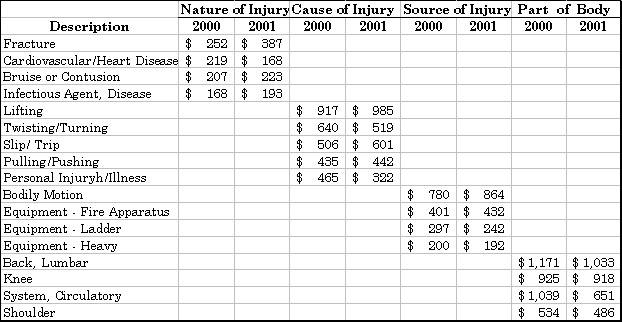
The Fire Department"s safety program should be managed by a highly ranked employee, either administrative-uniformed or civilian, to underscore program importance and ensure visibility. Such an employee ideally would have a strong background in the management and administration of occupational health and safety programs. The program would address, at a minimum, the following specific areas on a Department-wide basis: safety policy, legal compliance, injury and illness prevention, safety education and monitoring (working in conjunction with the Training Division staff), physical fitness, regular inspection of Departmental facilities and apparatus, and a reward system for exemplary performance by employees in achieving specific program goals and objectives.
In addition, the program should include a strong and technically current but flexible management information system component to assist with expanded tracking and reporting responsibilities. The above table illustrates that an enormous amount of information is currently available to the Department regarding injuries and costs. What is needed is a systematic approach to analyzing the data and taking recommended corrective action. Finally, the Department would ensure compliance with state-mandated occupational health and safety requirements through this program.
The creation of a comprehensive and strategic industrial safety program that embraces the full range of human and environmental factors in a proactive and systematic way will be of significant benefit to the Fire Department. Such a program should serve as the focal point for analyzing critical information on attendance, leave usage and industrial injuries, so that management can implement some of the corrective measures discussed in this report to reduce costs in the areas of overtime, disability pay, sick leave and workers compensation.
Two positions are recommended to staff this program as shown below.
|
Classification |
Salary & Benefits |
|
|
H30 Captain (or equivalent civilian) |
$110,661 |
|
|
6137 Assistant Industrial Hygienist |
80,535 |
|
|
Total |
$191,196 |
Establish Practicable Targets for the Use of Leave Benefits
Eight different categories of leave are monitored in the Department"s current automated tracking system. The Budget Analyst believes that five of these categories represent entitlement benefits where significant management intervention is unnecessary. However, there are three categories for which just the opposite is believed to be true in terms of intervention: sick leave, disability pay, and temporary modified duty.10 These three categories represent a class of employee benefits with some discretionary characteristics that can be either abused by employees, or wielded by management as inducements. For example, the Pilot Wellness Incentive Program was designed specifically as an inducement to reduce the (abusive) use of sick leave; disability pay confers a higher benefit for industrial injury to uniformed personnel than to civilians; and temporary modified duty has the potential for abuse at the same time that it is used by the Department to encourage injured workers to return to active duty from disabled status.
The use of these specific leaves has been tracked by the Department for some time, as noted in a separate section of this report. One issue facing the Department is whether to passively track this usage or to proactively apply historical trends combined with current knowledge of the basis for particular leave patterns toward cost-reduction objectives and performance measures. From a management perspective, the latter has substantial benefits, including, but not limited to, the following:
· A safer and more pleasant work environment;
· Lower absenteeism rates and increased productivity;
· Assured compliance with applicable occupational health and safety regulations;
· Reduced costs for overtime, workers compensation and disability pay; and
· Safety conscious managers operating within a culture of safety.
The notion of targeted rates for usage of disability pay, sick pay and limited duty provides measurable objectives for supervisors and managers. It also has a financial component inasmuch as reducing usage reduces cost. Supervisory personnel become more aware of their responsibility in these areas through training (from the safety program), and learn how their performance will be measured in relation to how well or poorly they perform. As one component of an overall safety thrust in the Department, this strategy can provide reinforcement.
Another issue for the Department in establishing targets is the calculation methodology. The fundamental structure for this aspect is addressed in the section of this report dealing with staffing requirements and relief factors. However, important keys are the number of employees scheduled for duty and the base the Department chooses for measuring accomplishment. The answers to these questions should be determined by the Finance Officer working jointly with the safety program staff.
The final issue is simply one of practicality. The targets must be reasonably attainable; out of immediate reach, but not out of sight. It will be important that targets are transposed from broad, Department-wide goals and shaped to the specific organizational unit of individual supervisors. The crafting of measurable objectives in this regard should be as specific as reducing each unit"s number of average daily absences in the applicable combination of the three categories by an agreed upon amount.11 The operant phrase is "agreed upon." Managers and supervisors agree beforehand on the level of leave reduction they believe is possible for their respective units in a given period, on the basis of their knowledge of individuals currently on leave and their commitment to improve.
In broad terms, the Departmental goals for daily averages in the three areas could be as follows (based on a daily average of 447 employees scheduled for duty):
Sick Leave: An average of 24 FTEs per day (5%), based on an assumption that the Pilot Wellness Incentive Program will have some impact. The remainder would be more legitimate usage. This represents a reduction of only one FTE per day, and a change of 1% from the Fiscal Year 2000-01 rates (this is the average percentage rate for both the past seven and the past four years).
Disability: An average of 18 per day (4%), since changes in this area will yield the greatest results because it is the highest-cost area. This represents a reduction of two daily absences and a change of 1% from the past seven- and four-year periods, as well as the Fiscal Year 2000-01 rates.
Limited Duty: An average of 12 per day (3%), based on an assumption that this is a beneficial leave category for the Department, and it will be properly utilized. The daily average is one less than the rate in Fiscal Year 2000-01, but the percentage is the same. (The percentage is one percent higher than the average rate over the past seven and four years.)
Enhance Disability and Workers Compensation Claims Management
The Department currently has three positions dedicated to a variety of tasks pertaining to physical examinations, industrial injuries, return to work, temporary modified duty, and absence from work for medical reasons. These positions are the Department Physician, Nurse Practitioner, and Medical Leave Supervisor. Given the size of the Department"s overall staff and the current rate of injuries, illnesses and related absences, the workload exceeds the capacity of these three positions. The incumbents are just able to react to the demands placed on their respective offices without performing any analytical work to assess causes, develop recommendations, or implement and monitor corrective measures.
As noted previously, the Department lacks a comprehensive industrial safety program. However, if the Budget Analyst"s recommendation to create such a program is implemented, the Department will be in a position to bring the coordinated resources of the Physician, Medical Leave Supervisor, Human Resources Division, Finance, Assignments Office and Training Division -along with the safety program-- to bear on the issue of injury and illness claims. A central office with this overall responsibility would be the first critical step toward more effective internal management of large cost drivers such as workers compensation and disability, and for essential external liaison with the Department of Human Resources Workers Compensation Division and the City"s Retirement System.12
The DHR/WCD has installed a new claims management system. The timing provides the Fire Department with an opportunity to ensure that its PeopleSoft system is synchronized with the City"s claims management system. This new system is the major tool available to the Department for specifying its data needs and hierarchy, and developing custom reports on claims activity and associated costs for regular use by management.
Creating a comprehensive industrial safety program whose staff would work closely with the DHR/WCD and Retirement System to expand data collection and reporting capabilities represent the two most powerful steps the Department can take to enhance its disability and workers compensation claims management. Without detailed information on specific claims, claim and injury types, costs, etc., the Department cannot begin to develop effective strategies to mitigate their impact.
Conclusions
Departmental costs related to industrial injuries and illness are high and generally increasing. In part, this condition may result from leave abuses, reflected in the high use of overtime and disability claims, and permitted by weak internal controls. On average, more than 20 percent of the uniformed employees scheduled for fire suppression duty were absent every day in Fiscal Year 2000-01 under the aegis of several approved leave categories. The interrelationship of these different categories is complex, often obscuring the total cost impact. To illustrate: the costs for overtime, workers compensation and disability pay together exceeded $24 million in Fiscal Year 2000-01, which is more than 11 percent of the Department"s current year operating budget. Sick leave and temporary modified duty (aka limited duty) are other cost-driving components of this overall problem, but their direct dollar costs are not included in the $24 million.
While a historical adverse expenditure trend appears to be changing in the area of workers compensation and new return-to-work efforts are now underway, much more is needed in the areas of injury education and prevention, and information gathering and reporting. Taken together, these trends and interrelationships illustrate the fundamental deficiency uncovered by our review: the Department lacks a comprehensive and strategic industrial safety program. There is no central office or position assigned the responsibility of coordinating the Department"s resources in a systematic approach to cost reduction in these related areas. Notwithstanding the complexities and financial impact of this specific problem, the Budget Analyst believes that the safety program is the first and most important step toward a solution. Two positions are recommended to staff this function with their organizational placement to be specified by the Chief of the Department. There are additional measures that the Department can implement to ensure success, all of which should be coordinated as integral parts of the comprehensive safety program.
The Fire Department should continue working with the Department of Human Resources Workers Compensation Division on related information systems applications, seek to mitigate disability retirement costs through more rigorous review of claims, expand return-to-work activities while stabilizing the use of limited duty, convert uniform positions to civilian positions where appropriate to reduce disability pay exposure, and vigorously monitor and manage disability pay. Additionally, the Department should establish practicable targets for the use of leave benefits and enhance the disability pay and workers compensation claims management processes.
Recommendations
The San Francisco Fire Department should:
1.7.1 Create a comprehensive Safety Program to ensure that activities pertaining to sick leave, disability pay, workers compensation and limited duty are properly coordinated with other Departmental activities-such as recruitment, training and financial management-and administered to reduce the impact on overtime and optimize the use of limited duty.
1.7.2 Establish practicable targets through and in cooperation with the Safety Program for the use of sick leave, disability pay and limited duty assignments in the Department"s staffing model.
1.7.3 Utilize its current authority to initiate Industrial Disability Retirements, as appropriate.
1.7.4 Participate more directly with the Department of Human Resources Workers Compensation Division in the careful review of all retiree claims to ensure in a timely manner that they meet the legal requirements for acceptance and are not improperly approved due to inattention or carelessness.
1.7.5 Assist in the vigorous scrutiny of all new industrial injury claims by active uniformed personnel for assurance of adequacy before acceptance.
1.7.6 Continue working with the Department of Human Resources Workers Compensation Division to enhance the Fire Department"s information system applications for purposes of a comprehensive safety program, tracking claims and more effectively dealing with industrial injuries and illnesses.
1.7.7 Establish two positions (H30 Captain or equivalent civilian and 6137 Assistant Industrial Hygienist) to manage a comprehensive and strategic industrial safety program that addresses the full range of human and environmental factors in a proactive and systematic way.
1.7.8 Convert uniform positions to civilian positions where appropriate to reduce disability pay exposure (please refer to Section 2.3 of this report).
1.7.9 Vigorously enforce the Department"s existing policy of a one-year limit on limited-duty assignments.
1.7.10 Work cooperatively with the Department of Human Resources and establish internal procedures to monitor sick leave use against the Pilot Incentive Wellness Program to validate its effectiveness.
Costs and Benefits
The creation of a Safety Program for the Department is projected to cost $191,196 annually for two positions. Beyond that, the program will have no additional costs since they will be based on the reallocation of existing resources.13
The annual benefits from this recommendation, however, are expected to be in the $250,000 range, covering reduced accident and industrial-injury claims cost as well as less damage to property. This benefit amount would not include the separate savings from newly achieved targets of lower sick and disability pay usage, and a stabilized level of limited duty, conservatively accounting for an additional $800,000 combined.
Implementation of the Industrial Disability Retirement recommendation will result in a conservative estimate of $150,000 in savings per year. The Wellness Incentive Program will have no cost impact above the amount for the current program, but result in an additional minimum annual savings of $150,000, based on the number of eligible employees who retire.
Reviewing workers compensation claims of active uniform personnel and retirees more vigorously is projected to require only one person day per month total, and result in savings of $100,000 each year over the Fiscal Year 2000-01 base.
More aggressive recruiting in the manner recommended will allow the Department to maintain a ready pool of lateral hires and cadet candidates for placement in the training classes, scheduled to coincide with planned separations. Similarly, working with the Department of Human Resources Workers Compensation Division to coordinate claims management information system issues and procedures will provide the Department with state-of-the-art data management and reporting capabilities to support and enhance the Safety Program.
Removing selected premiums from the disability pay calculation would most likely be part of a resources exchange since the recommendation requires negotiations with the Firefighters Local 798. However, it is assumed that even under such circumstances, this action would result in net savings of at least an estimated $50,000 each fiscal year.
Enforcement of the existing limited duty policy is viewed as a no-cost item.
The total of all estimated savings is at least $1.3 million annually. The actual savings would be determined by the number of sworn personnel that retire, and their individual sick-leave balances and length of service
Exhibit 1.7.9
Detailed Workers Compensation Expenditures, Three Fiscal Years
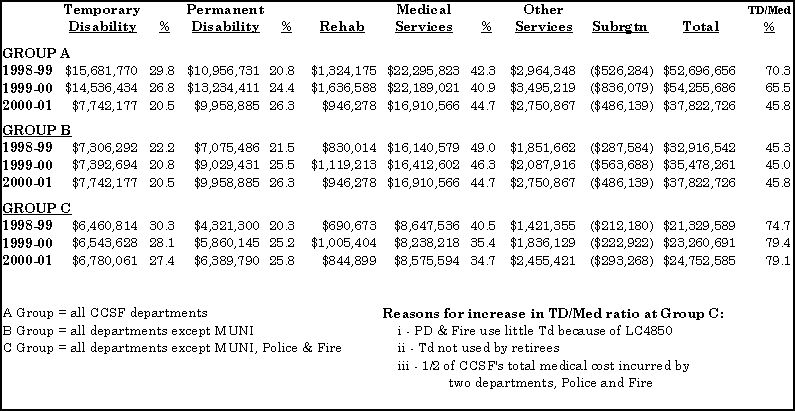 All City Departments, Without MUNI, & Without MUNI, Police & Fire
All City Departments, Without MUNI, & Without MUNI, Police & Fire
1 Limited duty is counted as an absence in the calculation of WDOs since it refers to a firefighter who is scheduled, but unable to perform suppression duties due to physical restrictions ordered by treating physicians in industrial injuries, and personal physicians for non-industrial injuries.
2 Leave categories such as vacation, jury duty and military leave are not appropriate areas for management to intervene in search of cost savings.
3 This is accomplished on a routine basis through the Assignment Office by first scheduling long-term vacation relief personnel, then drawing from the daily and voluntarily derived "WDO Hit List," by seniority and rank, to fill the remaining short-term vacancies.
4 Technically, the total overtime cost is less than that for hiring another employee for backfill purposes, a matter discussed and illustrated later in this section.
5 This table shows projections both with and without the Airport and Radio units.
6 The firefighters" retirement fund, which is a defined benefit plan, currently has excess earnings that are used to fund a portion of the City"s annual contribution requirement. This amount is substantial, reducing the City"s mandatory firefighter benefit costs by approximately $26,9 million in FY 2000-01. However, with the recent downturn in the economy, it is not clear how long the City will continue to earn sufficient investment income that can be used to fund this obligation in future years.
7 Firefighters are among the classes of public safety personnel covered by this provision. Throughout much of California, this provision is Section 4850 of the State Labor Code. However, Section A8.516 of the Charter of the City and County of San Francisco is the enabling legislation for this benefit in San Francisco and it supercedes LC 4850.
8 Fire Department claims are adjusted by DHR/WCD staff and SFFD staff provide assistance.
9 The recently negotiated MOUs include provisions that remove selected premiums from the calculation of base wage for disability pay, a prior recommendation of the Budget Analyst.
10 These three categories of leave result from collective bargaining, charter amendments and good business practices.
11 Every unit may not necessarily have employees utilizing each of the three categories of leave. Thus, their respective targets will vary based on their current situations. Maintenance of a leave-free unit over consecutive time periods would be an acceptable target in the case of a unit in which no leave currently is being utilized.
12 The relationship and interaction with the Retirement System are important for processing Industrial Disability Retirements.
13 All of the currently appropriated safety funds are for equipment rather than a programmatic approach as recommended. Only a portion of those funds would be reallocated for this new program. It is further assumed that one or more of the positions targeted for elimination in a separate recommendation could be moved to staff this new program.
